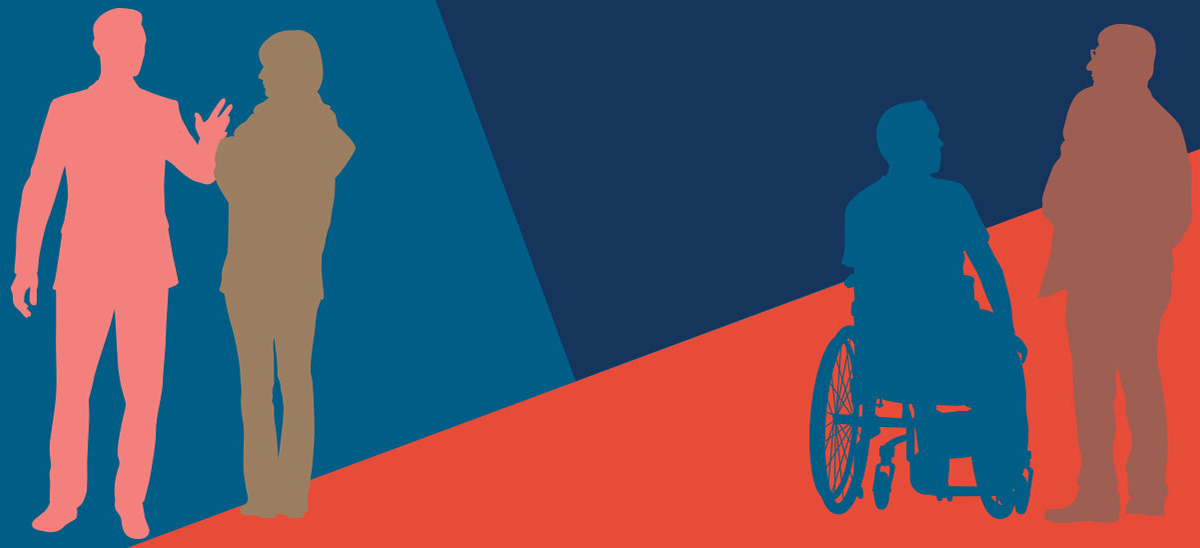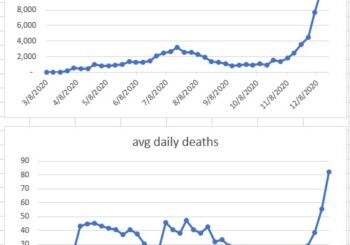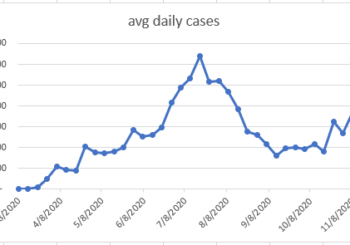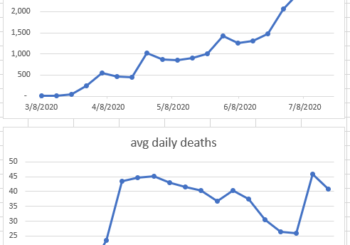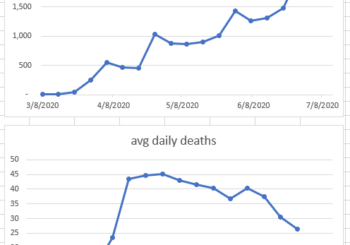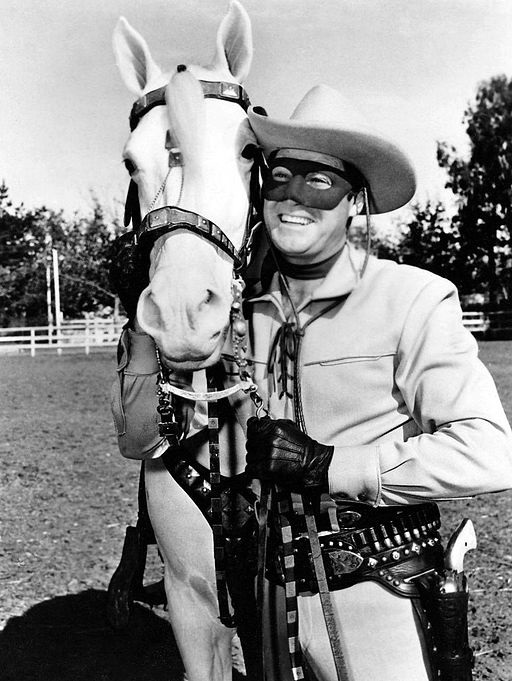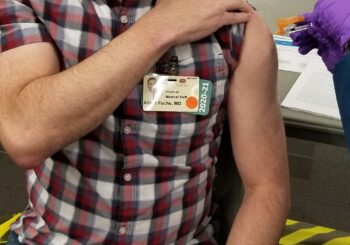
or
This Pandemic Will End in Tiers
Sunday, January 17, 2021

The Short Version for Readers Who Want Clear Instructions and Little Else
[This section was updated on Friday, January 22, and will be updated periodically.]
- Keep an eye on the LA County Dept of Public Health COVID-19 Vaccine Distribution site. Know your phase and tier. If you’re 65 or older, scroll down to Phase 1B and click on the “Persons age 65 and over How to get vaccinated” button. That will take you to another page that lists the documents required for a vaccination appointment. Read it, scroll to the bottom and click on the “Make an appointment to be vaccinated by LAC DPH and partners” button. That site will let you choose a location and (if available) make an appointment.
- The County Dept of Health has a call center for residents without computer access. Call 833-540-0473 between 8:00 am and 8:30 pm 7 days a week for assistance with appointments.
- Carbon Health, one of the vaccine distributors in charge of some of the vaccination locations (including Dodger Stadium) has a website that can be reached directly. The LA County link above will also get you to the same website if you choose one of their locations, but if you want to try their website directly, it’s here.
- If you want to receive the vaccine at Cedars-Sinai Medical Center and you don’t already have a My CS-Link account, create one here. They do not yet have doses or appointments for patients 65 and over, but people with My CS-Link accounts will be informed as soon as they do.
- Consider signing up for email newsletters with vaccine updates from the LA County Dept of Public Health.
- Please don’t call your doctor’s office with questions about vaccine scheduling. If you can’t find the information you seek online, it’s likely that your doctor doesn’t know either. If you must reach out to your doctor’s office about this, please make every effort to use an asynchronous method (email, patient portal, fax). Leave the phone lines for the poor folks with medical problems.
The Long Version for Readers Who Enjoy More Education / Editorializing / Bloviating
Vaccine distribution has become a mess. But that noun is terribly inadequate for the situation.
The pharmaceutical industry has just completed one of the greatest scientific and logistical marvels of my lifetime. Pfizer and Moderna, with Johnson and Johnson and others right behind them, have created, tested, and manufactured millions of doses of safe and effective vaccines for a disease that only came into being 13 months ago. Drunk with the euphoria of that accomplishment, I had assumed that state and local governments, working with local hospitals and pharmacies, would rise to an equally demanding project – administering the vaccine to hundreds of millions of people.
It is still early days, but so far, vaccine distribution in LA County is a mess. But a mess is what happens when you drop an egg. To describe what happens when millions of patients have no reliable centralized source of information, when they circulate rumors of where vaccine might be available, when by the thousands they call their doctors whose poor receptionists don’t know any more that what the patients have heard on the news, to describe that situation one must reach for military acronyms or foreign words. So far, vaccine distribution in LA County is fubar. It is a big snafu. It is a balagan.
The centralized place that was supposed to contain up-to-date information about vaccine distribution in LA County is the LA County Dept of Public Health website. Please take a look at it. It’s clear. It’s organized. It lets you see which phase and tier you’re in and provides a rough guess as to when that phase and tier will receive the vaccine. What could go wrong?
Well, it sounds like private companies who have volunteered to distribute the vaccine, like Ralphs, Rite Aid, and others, worked with the State to organize their vaccine administration schedule and request vaccine doses. That’s a very good thing. The more options there are to get a vaccine the better. Also, last week Gov. Newsom changed phase 1 to include all people 65 and older. (Prior to that the cutoff was 75.) That’s also a good thing. The sooner we can vaccinate all older patients, the better. The problem was that the County website didn’t reflect any of these changes for days.
Patients, on their own initiative (or following links from the California site), found that Ralphs was already making appointments for the vaccine. This information spread like wildfire and I soon heard from patients that the site was inundated and working poorly. There was no longer any reliable comprehensive centralized source of information, leaving patients to act on emails from their sister-in-law’s accountant, who’s a very nice guy. To make matters worse, some officials were telling the public to call their primary care doctor with questions, when we were as in the dark as the public. So our long-suffering receptionist spent most of last week telling frustrated callers “We don’t know either,” while patients clicked the refresh button on the Ralphs site like rats in a cocaine experiment.
The dust hasn’t yet settled. What is clear is that the vaccine will be distributed through large medical centers and large pharmacy and supermarket chains. (It is possible that some private doctors’ offices will carry the vaccine too, and we’re still trying to figure that out for our office.) The logistical complication thus far is that a patient has to choose a vaccination site prior to making an appointment. Meaning, vaccinations at all Ralphs will be scheduled through Ralphs’ website; vaccinations at Cedars will be scheduled through the Cedars patient portal, etc. What would be far superior is a single centralized place where a patient can enter her demographics and be given a list of the soonest appointments available at any vaccination site close to them. That would require cooperation between all the vaccination sites to have one integrated scheduling mechanism, and it would require a few programmers to build such a thing. Oh, and it would require local leadership.
For now, your best bet (probably) is to sign up with the patient portal of the large medical center closest to you (or the one you frequent most). Cedars-Sinai Medical Center’s patient portal is My CS-Link, and if you don’t have an account you can create one here. They recently sent an announcement to all patients that included the following.
When you have the option to receive the COVID-19 vaccine, we encourage you to get vaccinated. Like all positions Cedars-Sinai has taken during the pandemic, this position is based on the latest scientific data—which favor the vaccine as a safe and powerful way to stop the spread of COVID-19.
At present, we don’t know exactly when we will be able to offer vaccines to our patients. We do want you to know, with complete confidence, that when we are authorized to proceed, we will notify our patients immediately. We also want to remind you that your My CS-Link™ account is the fastest, most reliable way to receive up-to-date information about the vaccination process and will help to streamline appointments when scheduling becomes available.
That may be the simplest option for now. Pick the medical center where you’d like to receive the vaccine. Sign up for their patient portal. And wait. Occasionally, take a look at the LA County site to get an idea of when to expect your tier to get vaccinated. And wait some more.
If I learn of a better information source that lists all the available vaccine administration sites, or if a centralized vaccine appointment scheduling site is developed, I’ll let you know. Until then, please continue to stay out of each other’s homes, maintain distance from others in public places, and, as much as possible, stay home. Please stay well.
[This post is dedicated to the memory of Dr. Anny Jacoby, my aunt, who died last week at the age of 89. She had a long career as a pediatrician in Jerusalem. She was an inspiration to me as a brilliant and caring physician and as a devoted spouse and parent.]
Learn more:
COVID-19 Vaccine Distribution in Los Angeles County (County of Los Angeles Public Health)
COVID-19 Vaccine information, including sign up for email newsletter (County of Los Angeles Public Health)
My CS-Link (the patient portal for Cedars-Sinai Medical Center)
Ralphs COVID-19 vaccine appointment website
